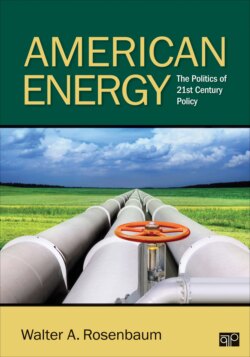Читать книгу American Energy - Walter A. Rosenbaum - Страница 19
На сайте Литреса книга снята с продажи.
Governing Energy: The States
ОглавлениеThe States are important policymakers and stakeholders in US energy affairs. As policymakers, states share with Washington regulatory agencies the authority over energy production and distribution. Energy producing states, such as Oklahoma, Louisiana, and Texas, set the allowable rate for oil and gas production from existing wells, but the federal government, until recently, mandated the wellhead price of natural gas moving through interstate pipelines. The Energy Policy Act of 2005 requires that federal and state regulatory agencies share authority for the siting of interstate power transmission lines.32 State regulatory authorities customarily set rates and other standards for investor-owned utilities—how much electricity, for instance, must be produced from renewable energy sources. Both federal and state governments regulate the siting of commercial nuclear power plants, tax energy production, such as coal production, and set health and safety standards for energy facilities. By 2014, federal-state collaboration in promoting energy conservation had emerged as an important aspect of national energy policy.33 Most federal energy regulations are also enforced through the states.b
b During the energy crises of the 1970s, Congress authorized the states to enforce many other regulatory programs including the development of emergency preparedness plans, heating and cooling standards for buildings, weatherization programs for residential dwellings, and reform of electric utility pricing policies.
States are also stakeholders in the energy economy. The states well-endowed with fossil fuel or hydropower resources (sometimes called the “energy patch”) are heavily dependent economically upon energy production, highly sensitive to changes in the supply, demand, and price for energy, and fiercely protective toward the political and economic interests of their energy producers. Any sharp decline in world petroleum prices, or significant increases in global petroleum production, can create sometimes severe, adverse impacts upon the energy states. Few states are more vulnerable to changes in the domestic petroleum supply and prices than Alaska, where all state enterprises have been subsidized by petroleum revenues. In 2013, Alaska’s fossil fuel royalties were about $2.14 billion, or more than 90 percent of the state’s total revenue income. (Every Alaska citizen also receives an annual share of this wealth, which has varied in recent years between $ 1,600 to $878 for each individual).34 “Energy poor” states heavily dependent upon imported petroleum and natural gas, primarily in the Northeast, are vigilant to promote favorable regulation of national energy prices and energy transportation infrastructures essential to their economic growth.
Historically, the energy-producing states have been aggressive in creating regional energy alliances to protect or to expand their domestic and global energy markets and to limit petroleum production, if possible, when it seemed expedient to protect domestic petroleum prices. The energy producers, especially the coastal states, have also been ambiguous and vacillating about federal government efforts to promote more energy production within their jurisdictions. This has been a contentious matter for states with potential fossil fuel reserves on their Outer Continental Shelf (OCS) lands—especially California, Louisiana, Oregon, Washington, Texas, Hawaii, Massachusetts, North Carolina, and Alaska—where fears of an environmental disaster, such as Deepwater Horizon, continually clash with the economic enticements of energy production.
There is no ambiguity, however, about the constant enthusiasm among almost all states to capture a portion of federal spending on energy-related activities, especially when the spending is generous. For example, after Congress enacted the American Recovery and Reinvestment Act (2009), providing $3.4 billion in federal support for innovative “clean coal” technology development, public officials in Texas, Illinois, and several other states immediately launched an extensive media and political campaign to convince Energy Secretary Steven Chu to invest in their competing clean-coal power plants, which would be among the most costly electric power plants ever proposed and a huge economic stimulus to the winning state.35
The states have also been energy “policy laboratories” where innovative energy policies have originated, sometimes becoming models for federal policy and often generating pressure on a reluctant Washington to act on energy issues. Recently, numerous states have enacted legislation or regulations creating Renewable Portfolio Standard (RPS), requiring utilities to generate a portion of their power from renewable energy sources. And, while Congress and the White House have debated and deadlocked since 2000 about creating a national regulatory policy to control climate-warming emissions (greenhouse gases, or GHG), a number of states have enacted various regional “cap-and-trade” regulatory strategies and other innovations to initiate their own regulatory regimes to cap their GHG emissions.36
